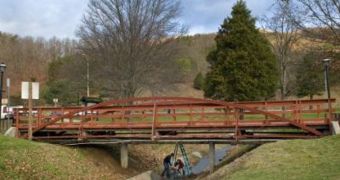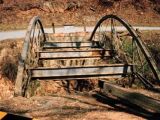An iron truss bridge that has been in operation for more than 100 years has now been restored and put back to use, after years of being neglected. It was bypassed in the 1970s, and it has fallen in disrepair since. However, a Virginia Tech undergraduate student conducted a serious load-bearing test on the old structure, which provided good results. As a direct consequence, the bridge was restored, and is now used as a passing point for pedestrians, having been moved from its original location, at Roaring Run in Bedford County to the I-81 Ironto.
The new load test was the first one to be conducted on the bridge, civil engineering student Elaine Huffman believes. “There was no documentation of a structural analysis from when the bridge was designed,” she says. Interested in the historic landmark, which was patented in 1859, the student did a full literature review, then set out to develop a computer-based structural analysis of the object. It was only recently that she managed to verify the computer model with an actual load test.
“The Virginia Transportation Research Council recognized the importance of the bridge as a historical landmark and worked to preserve it by restoring it and putting it into use elsewhere. Much work was put into determining the original paint scheme and recreating it once the bridge was relocated. The new site was selected to maintain the function of the bridge,” Huffman says. She also reveals that there are a number of unique features to the bridge, including “a unique bracing system perpendicular to the truss that restrains lateral movement of the Arch. Cross braces prevent longitudinal motion of the bridge deck as it hangs from the vertical cables.”
The actual tests were conducted on December 3, when a three-ton truck was driven across the bridge, after dial gages were installed under each truss. The devices allowed Huffman and her team to analyze the deflections recorded in each of the trusses. “The bridge behaved as expected for the most part. The maximum deflection recorded for one truss was 0.14 inches, 70 percent of the result predicted by the model. However, the second truss deflected a smaller amount. Preliminary analysis suggests that the diagonal cable members have loosened over time and are supporting the bridge loads unevenly, allowing one truss to deflect more than the others,” the student adds.
The new results will be used in the University of Massachusetts Amherst's Adaptive Bridge Use Project, an initiative that aims to restore and study historic bridges. The project is supported via a grant from the US National Science Foundation (NSF), and also seeks to increase structural engineering curriculum and preserve examples of bridge designs from the past. “Perhaps the analysis will aid in the future assessment of the bridge's condition as it continues to be preserved as a historic landmark,” Huffman concludes.

 14 DAY TRIAL //
14 DAY TRIAL // 
